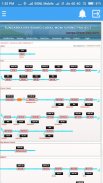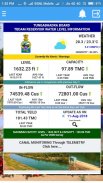






TBPLIVE

Description de TBPLIVE
Welcome to the Tungabhadra Board, Reservoir Storage Management System Portal. The River Tungabhadra derives its name from two streams viz., the Tunga,
about 147 km(91.6 miles) long and the Bhadra, about 178 Km (110.9 miles) long which rise in the Western Ghats. The river after the influence of the two streams near Shimoga,
runs for about 531 Km(330 miles) till it joins the river Krishna at Sangamaleshwaram in Andhra Pradesh. It runs for 382 Km (237 miles) in Karnataka, forms the boundary between
Karnataka and Andhra Pradesh for58 Km (36 miles) and further runs for the next 91 Km (57 miles) in Andhra Pradesh. The total catchment area of the river is 69,552 Sq Km
(26,856 Sq miles) up to its confluence with Krishnaand it is 28,177 Sq Km (10,880 Sq miles) up to Tungabhadra Dam. It is influenced chiefly by the South-West monsoon. It is a
perennial river but the summer flows dwindle to as low as 2.83 to1.42 cumec (100 to 50 cusec).
Bienvenue sur le tableau Tungabhadra, portail du système de gestion du stockage de réservoirs. La rivière Tungabhadra tire son nom de deux ruisseaux, à savoir le Tunga,
environ 147 km de long et la Bhadra, environ 178 km de long qui monte dans les Ghâts occidentaux. La rivière après l'influence des deux cours d'eau près de Shimoga,
parcourt environ 531 km (330 miles) jusqu'à ce qu'il rejoigne la rivière Krishna à Sangamaleshwaram dans l'Andhra Pradesh. Il parcourt 382 km au Karnataka, formant la frontière entre
Karnataka et Andhra Pradesh pour 58 km (36 miles) et continue pour les prochains 91 km (57 miles) à Andhra Pradesh. Le bassin versant total de la rivière est de 69 552 km2
(26,856 miles carrés) jusqu'à sa confluence avec Krishna et il s'élève à 28 177 kilomètres carrés (10 880 miles carrés) jusqu'au barrage de Tungabhadra. Il est principalement influencé par la mousson du sud-ouest. C'est un
rivière pérenne mais l’été s’écoule à 2,83-1,42 cumec (100 à 50 cusec).

























